
Josef Antonius Heinrich Terboven was a German Nazi Party official and politician who was the long-serving Gauleiter of Gau Essen and the Reichskommissar for Norway during the German occupation.

Ernst Friedrich Christoph "Fritz" Sauckel was a German Nazi politician, Gauleiter of Gau Thuringia from 1927 and the General Plenipotentiary for Labour Deployment (Arbeitseinsatz) from March 1942 until the end of the Second World War. Sauckel was among the 24 persons accused in the Nuremberg Trial of the Major War Criminals before the International Military Tribunal. He was found guilty of war crimes and crimes against humanity, sentenced to death, and executed by hanging.
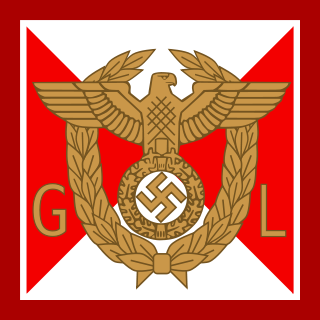
A Gauleiter was a regional leader of the Nazi Party (NSDAP) who served as the head of a Gau or Reichsgau. Gauleiter was the third-highest rank in the Nazi political leadership, subordinate only to Reichsleiter and to the Führer himself. The position was effectively abolished with the fall of the Nazi regime on 8 May 1945.

Karl August Hanke was an official of the Nazi Party (NSDAP) during its rule over Germany who served as the fifth and final Reichsführer of the Schutzstaffel (SS). He also served as Gauleiter of Gau Lower Silesia from 1941 to 1945 and as Oberpräsident of the Prussian Province of Lower Silesia. Captured on 6 May 1945, he was shot and wounded during an escape attempt and then beaten to death by Czech guards on 8 June, after the war had ended.
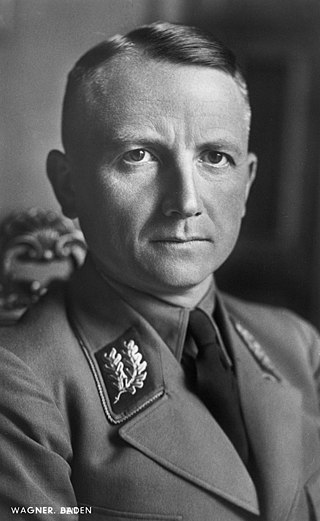
Robert Heinrich Wagner, born as Robert Heinrich Backfisch was a Nazi Party official and politician who served as Gauleiter and Reichsstatthalter of Baden, and Chief of Civil Administration for Alsace during the German occupation of France in World War II.
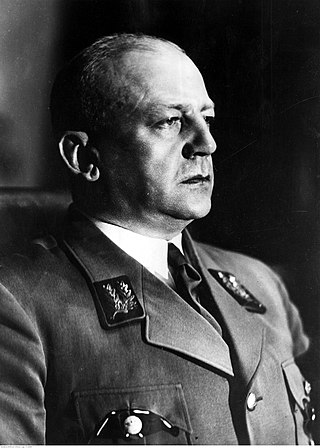
Adolf Wagner was a Nazi Party official and politician who served as the Party's Gauleiter in Munich and as the powerful Interior Minister of Bavaria throughout most of the Third Reich.

Jakob Sprenger was a Nazi Party official and politician who was the Party's Gauleiter of Hesse-Nassau South from 1927 to 1933 and Gau Hesse-Nassau from 1933 to 1945. He was also the Reichsstatthalter and Minister-President of the People's State of Hesse, the Oberpräsident of the Prussian Province of Nassau and an SA-Obergruppenführer.
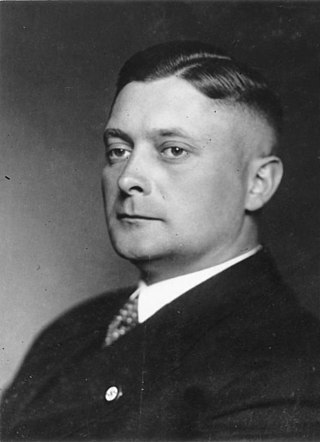
Karl Kaufmann was a German politician who served as a Nazi Party Gauleiter from 1925 to 1945 and as the Reichsstatthalter of Hamburg from 1933 to 1945.

Martin Mutschmann was the Nazi Regional Leader (Gauleiter) of the state of Saxony during the time of the Third Reich.

Rudolf Jordan was the Gauleiter in Halle-Merseburg and Magdeburg-Anhalt in the time of the Third Reich. After the war, he was sentenced to 25 years in a Soviet Union labour camp. He was released from the camp in October 1955, and died in Munich in 1988.
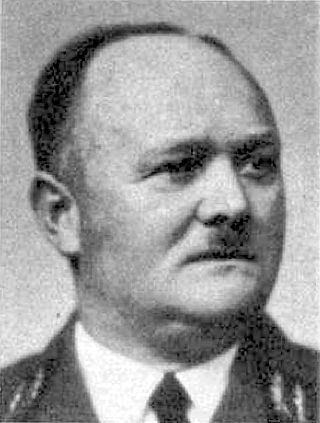
Karl Otto Paul Weinrich was a Nazi Party official and politician who was Gauleiter of Gau Kurhessen.

Wilhelm Murr was a Nazi German politician. From 1928 until his death he was Gauleiter of Gau Württemberg-Hohenzollern, and from early 1933 held the offices of State President and Reichsstatthalter of Württemberg. During World War II he also rose to the rank of SS-Obergruppenführer in addition to his Party posts. At war's end he committed suicide with poison while in French custody.
Otto Telschow was a German Nazi Party official who served as Gauleiter in Eastern Hanover from 1925 to 1945.
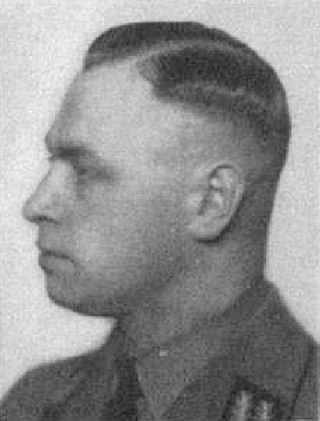
Josef Grohé was a German Nazi Party official. He was the long-serving Gauleiter of Gau Cologne-Aachen and Reichskommissar for Belgium and Northern France toward the end of the Second World War.

Gau Swabia, formed on 1 October 1928, was an administrative division of Nazi Germany in Swabia, Bavaria, from 1933 to 1945. From 1928 to 1933, it was the regional subdivision of the Nazi Party in that area.

The Gau Munich–Upper Bavaria was an administrative division of Nazi Germany in Upper Bavaria from 1933 to 1945. From 1930 to 1933, it was the regional subdivision of the Nazi Party in that area.

Paul Wegener was a German Nazi Party official and politician who served as the Gauleiter of Gau Weser-Ems as well as the Reichsstatthalter of both Bremen and the Free State of Oldenburg.
Emil Stürtz was a German Nazi Party official and politician who served as the Gauleiter in Brandenburg from 1936 to 1945.

The Gau Berlin was an administrative division of Nazi Germany from 1933 to 1945 in the German capital Berlin. Before that, from 1928 to 1933, it was the regional subdivision of the Nazi Party in that area. From 1926 to 1928 Berlin was part of the Gau Berlin-Brandenburg which was split into two separate Gaue on 1 October 1928.
The Council of Ministers for the Defense of the Reich was a six-member ministerial council created in Nazi Germany by Adolf Hitler on 30 August 1939, in anticipation of the invasion of Poland – which provoked the beginning of World War II – with the purpose of allowing the continuation of the Nazi government, especially in relation to the war effort, while Hitler concentrated on prosecuting the war. The council has been described as functioning as a "war cabinet," although this assessment is disputed.

















